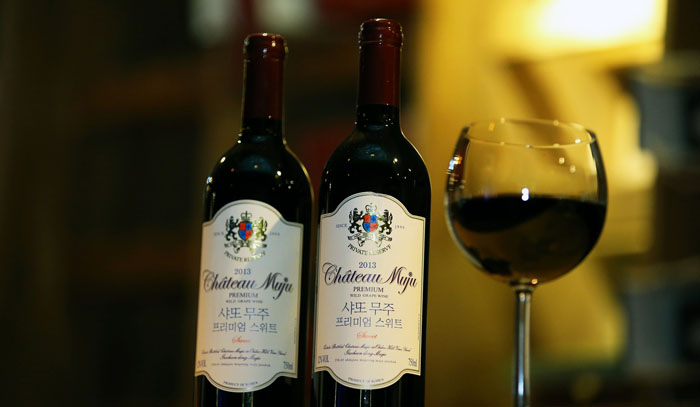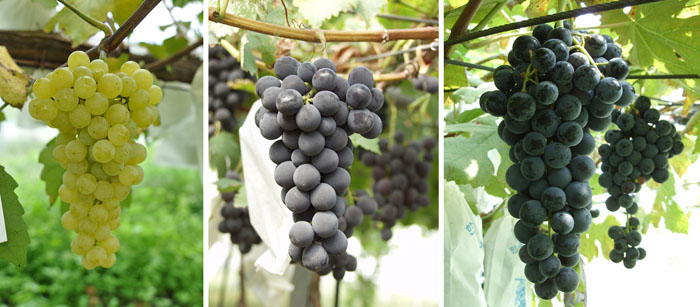-
 Korea.net's 24-hour YouTube channel
Korea.net's 24-hour YouTube channel- NEWS FOCUS
- ABOUT KOREA
- EVENTS
- RESOURCES
- GOVERNMENT
- ABOUT US
Korean wines are improving their taste and quality through the development of new grape varieties and by conducting research into farming techniques.
At a Korean wine exhibition last month, more than 100 Korean wines were on display, giving visitors a chance to taste their bouquets and to admire their aromas.

Grapes are one of the most common summertime fruits on the Korean Peninsula, and most of the grapes grown in Korea are sweet and are eaten raw fresh off the vine or immediately after harvesting. Wine grapes, however, commonly grown in Europe and South America, are rarely grown in Korea due to the weather, with a wet, humid summer and dry, cold winter. To overcome the peninsula's weather patterns and to help make better domestic wines, Korean wineries, agronomists and researchers joined forces to develop new varieties of grape that are both suitable for making wine and which can also grow here. They also invested time into studying wine-making techniques that use the sweet Korean grape varieties.
The fruits of these labors are three grape cultivars that are now used across the country for wine-making: cheongsoo, dunuri and narsha. Cheongsoo was developed in 1993 for white wines. This variety, with a tropical fruity flavor, has been grown and commercialized in wineries here. Dunuri was developed in 2006 for red wines and has a somewhat heavy flavor because of the tannins it contains. Finally, narsha, developed in 2009, began to be grown on farms in 2013. It's a hybrid with meoru, one of the homegrown varieties of grape, and can endure the peninsula's cold winters.

Besides these three varieties, other new cultivars are being developed. At present time, three candidates are being studied for a new breed of wine-making grape, and a variety that is most adaptable to Korean weather will be chosen, said the National Institute of Horticultural and Herbal Science (NIHHS), part of the Rural Development Administration.
Wines made from sweet Korean grapes are also being produced and bottled, and they have the flavor and aroma unique to Korean grapes and to Korean wines.
In all, Korean wineries and grape growers are improving their products' taste and quality through the development of new grape breeds, allowing them to grow, produce and bottle wines from grapes unique to the Korean terroir.
By Chang Iou-chung
Korea.net Staff Writer
Photos: Jeon Han, NIHHS
icchang@korea.kr
At a Korean wine exhibition last month, more than 100 Korean wines were on display, giving visitors a chance to taste their bouquets and to admire their aromas.

Chateau Muju is a local wine produced in Muju, Jeollanam-do Province (South Jeolla Province). It's crafted using a new homegrown grape variety, meoru, which has a deep and heavy flavor due to its tannins.
Grapes are one of the most common summertime fruits on the Korean Peninsula, and most of the grapes grown in Korea are sweet and are eaten raw fresh off the vine or immediately after harvesting. Wine grapes, however, commonly grown in Europe and South America, are rarely grown in Korea due to the weather, with a wet, humid summer and dry, cold winter. To overcome the peninsula's weather patterns and to help make better domestic wines, Korean wineries, agronomists and researchers joined forces to develop new varieties of grape that are both suitable for making wine and which can also grow here. They also invested time into studying wine-making techniques that use the sweet Korean grape varieties.
The fruits of these labors are three grape cultivars that are now used across the country for wine-making: cheongsoo, dunuri and narsha. Cheongsoo was developed in 1993 for white wines. This variety, with a tropical fruity flavor, has been grown and commercialized in wineries here. Dunuri was developed in 2006 for red wines and has a somewhat heavy flavor because of the tannins it contains. Finally, narsha, developed in 2009, began to be grown on farms in 2013. It's a hybrid with meoru, one of the homegrown varieties of grape, and can endure the peninsula's cold winters.

Korean wineries and researchers develop new grape cultivars so as to make better wines. Cheongsoo (left), dunuri (middle) and narsha (right) are now being grown in wineries across the country.
Besides these three varieties, other new cultivars are being developed. At present time, three candidates are being studied for a new breed of wine-making grape, and a variety that is most adaptable to Korean weather will be chosen, said the National Institute of Horticultural and Herbal Science (NIHHS), part of the Rural Development Administration.
Wines made from sweet Korean grapes are also being produced and bottled, and they have the flavor and aroma unique to Korean grapes and to Korean wines.
In all, Korean wineries and grape growers are improving their products' taste and quality through the development of new grape breeds, allowing them to grow, produce and bottle wines from grapes unique to the Korean terroir.
By Chang Iou-chung
Korea.net Staff Writer
Photos: Jeon Han, NIHHS
icchang@korea.kr
Most popular
- China warmly welcomes first Korea-born giant panda Fu Bao
- First hearing-impaired K-pop act hopes for 'barrier-free world'
- Novelist Hwang's 'Mater 2-10' shortlisted for Int'l Booker Prize
- Expats could account for 7% of population in 20 years: report
- Nat'l Fire Agency picks 137 elite staff for deployment abroad













